“We met in Miami when I was barely into adolescence. I fell in love at first sight. Although I was tender and impressionable at the time, and am now much older and shamefully experienced, my love remains steadfast and unrelenting. Granted the object of my affection is as rich as sin, and rich is a powerful aphrodisiac, but rich isn’t all. My love is also super smooth, exceedingly sensual and…well…how should I say it…completely satisfying. My breath quickens and heart pumps a tad faster at the very name: Key Lime Pie.I am obsessed. I am made hungry where most I’m satisfied. Once is never enough. All the clichés apply.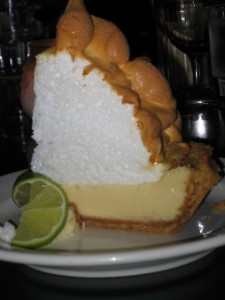
Fueled by passion, I became a stalker, or perhaps it’s nicer to say I went on a pie pilgrimage. In a secret effort to curb my promiscuous tendencies to adore each and every wedge that passes my plate, I headed to Key lime pie Mecca, the Florida Keys, to see if I could find an ultimate, peak-pie experience.
Everyone knows that this luscious substance, simply made with lime juice and sweetened condensed milk, was born in the Keys, but no one knows exactly when or where. Guesses are that Key limes, natives of Southeast Asia, came to the islands with the Spanish in the 1500s. It wasn’t until 1856, when Gail Borden created canned sweetened condensed milk, that a marriage of the ingredients was even possible.
I like the story that sailors were the matchmakers. Sailors cruising through the Keys carried supplies that didn’t spoil, such as hardtack and canned milk. They also picked up limes and eggs, which were readily available on shore. Can’t you just envision some galley cook trying to soften hardtack to an edible stage 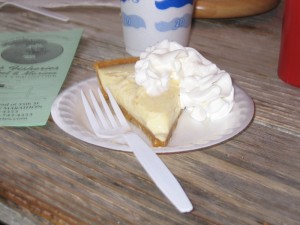 by crushing the rock-like crackers and soaking the crumbs in liquids at hand (lime juice, canned milk, an egg or two). Imagine the surprise when the acid in the lime “cooked” the proteins in the egg and milk, forming custard without the need for heat. What could be better than a delicious concoction, easily made from available ingredients, requiring no heat to cook.
by crushing the rock-like crackers and soaking the crumbs in liquids at hand (lime juice, canned milk, an egg or two). Imagine the surprise when the acid in the lime “cooked” the proteins in the egg and milk, forming custard without the need for heat. What could be better than a delicious concoction, easily made from available ingredients, requiring no heat to cook.
Necessity may have been he mother of Key lime pie, but taste was the father and their progeny flourished. Sailors took the recipe to shore and locals took it to heart, so the pie was an established favorite even before the first written recipe appeared in the 1930s.
As with all marriages, age brought change. Graham crackers replaced hardtack and traditional pie crust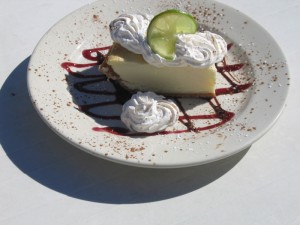 sometimes replaced the graham crumbs. The original pies probably went topless, but at some point a thrifty cook wanting to use egg whites left over from the yolks in the custard, added a layer of meringue. Whipped cream joined the topping choices when fresh milk came to the Keys with the railroad in 1912. The greatest change however, and a shocking travesty to purists, occurred when folks began making Key lime pie, without Key limes.
sometimes replaced the graham crumbs. The original pies probably went topless, but at some point a thrifty cook wanting to use egg whites left over from the yolks in the custard, added a layer of meringue. Whipped cream joined the topping choices when fresh milk came to the Keys with the railroad in 1912. The greatest change however, and a shocking travesty to purists, occurred when folks began making Key lime pie, without Key limes.
The real Key lime is a small thing, about the size of a ping-pong ball, with yellowish-green skin. Tart and juicy with distinctive aroma and flavor, Key limes grow on trees 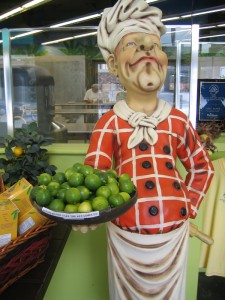 with thorny branches. When a hurricane devastated the Key’s lime crop in 1926, most growers replaced their plantations with Persian limes, which are easier to pick and transport. The larger, deep green Persian limes are found in most supermarkets today.
with thorny branches. When a hurricane devastated the Key’s lime crop in 1926, most growers replaced their plantations with Persian limes, which are easier to pick and transport. The larger, deep green Persian limes are found in most supermarkets today.
The salmonella scare brought recent change. Cooks, worried about raw eggs, began to heat the pies instead of letting limes do the work.
Surprisingly for a dish made with so few ingredients, no two pies are the same— and I should know, having sampled and savored pies from one end of the Keys to the other.
What did I discover?
As long as the base pie is made of lime juice and sweetened condensed milk, anything goes. Well, practically anything. Floridians insist that the pie be made of Key limes (although it is difficult for most cooks to find this baby) and everyone agrees it is forbidden to use food color to tint the custard green.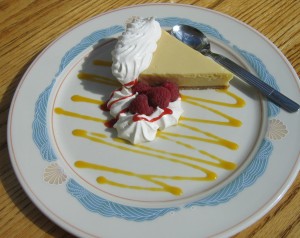
As to my preferences, as much as I would like to report that I developed a sense of discrimination, finding a sole, soul-mate pie, I have to confess that after trying the tall, short, thin, plump, creative, traditional, unadorned and accessorized-to-the max pies—I love them all.
On the other hand, faced with leaving the Keys and separating from my pie promiscuity, I did pick up the recipe for Little Palm Island’s cashew crusted, egg-yolk-rich, whipped-cream-drenched specialty. I’m going to take it home to meet the folks, as this is a happily-ever-after pie if there ever was one.
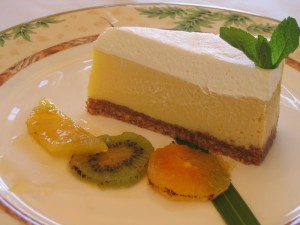
Little Palm Island's Key Lime Pie
LITTLE PALM ISLAND’S
KEY LIME PIE
2 cups very finely chopped or ground cashews
1 cup graham cracker crumbs
1/2 cup plus 2 tablespoons sugar, divided
3/4 cup melted butter
Shortening to grease pan
3 cups sweetened condensed milk
9 egg yolks
1–1/2 cups Key lime juice
2 cups heavy cream
Finely grated peel of one orange
Make crust: Combine cashews, crumbs and 1/2 cup sugar in a mixing bowl. Add butter and stir until well blended. Lightly grease a 9- or 10-inch springform pan and pat crumb mixture evenly and firmly over bottom. Bake in a preheated 350-degree oven until light golden brown, 8 to 10 minutes. Cool.
Make custard filling: In a large mixing bowl, beat milk and egg yolks until well blended. Slowly beat in lime juice. Pour mixture over prebaked crust. Bake in a preheated 300-degree oven until custard is set in center, 20 to 25 minutes. Set on a rack to cool completely.
Make topping: Put cream, orange peel and 2 tablespoons sugar in a mixing bowl and beat until stiff. Spread whipped cream over top of pie. Refrigerate until fully set, at least 1 hour. Cut around edge with a sharp knife and remove ring before serving.
Yield: 8 to 10 servings.
Check www.fla-keys.com for more about the Forida Keys.
